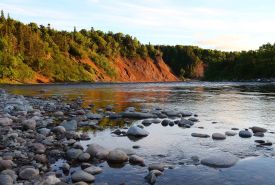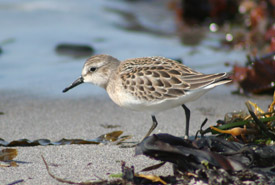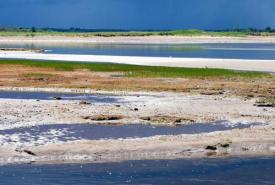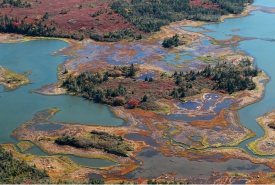Places worth protecting: Atlantic Canada

Crabbes River, NL (Photo by Mike Dembeck)
At the Nature Conservancy of Canada (NCC), we like to say we produce results you can walk on.
Without a doubt, the lands that NCC protects are the primary measure of our effectiveness and contribution to the conservation of Canadian nature in all its diversity, safeguarding the lands and waters that sustain life.
“What makes an area worth protecting?” and “How do you choose the areas you conserve?” are questions that NCC staff are often asked. These seemingly simple questions cut to the core of what it means to run an effective land trust organization, in addition to the values of our organization and how they translate into work on the ground.

Semipalmated sandpiper (Photo by NCC)
Conservationists commonly use the term ”ecological values” to describe why an area is, or should be, protected. These values generally fall into one of three areas: protecting rare or at-risk species and habitats, representing landscape diversity and maintaining habitat for wide-ranging “focal species” (species that move over large areas and have habitat requirements that benefit other species) or “keystone species” (species that play a critically important function in an ecosystem, upon which other species depend).
Additionally, an area may hold structural or strategic value, such as the ability to connect intact habitats or fill a hole in an existing protected area. In Atlantic Canada, NCC contributes to all three of these broad conservation themes.
High-priority conservation lands
With the notable exception of Newfoundland and Labrador, Atlantic Canada has the highest proportion of private land in the country, with 50 per cent in New Brunswick, 70 per cent in Nova Scotia and 90 per cent on Prince Edward Island. Settlement of the region was heavily clustered along the coast and in rich, fertile areas, such as along rivers, in valley bottoms and in areas with soils suited to growing crops. Due to their fertility, these areas often support outstanding ecological values that have been reduced and negatively impacted by hundreds of years of human activity. All of these factors combine to define an important niche for NCC and other land trusts: conserving the best of what’s left of our native ecosystems and wildlife habitat.

Barachois Dunes, NB (Photo by NCC)
From this broad direction, NCC must make important decisions about which specific places are of the highest priority. That’s why NCC has developed a sophisticated and science-based approach to conservation planning — or, picking the best areas to work on.
NCC’s Natural Areas Conservation Planning approach has produced 13 focused conservation plans to guide NCC’s work on the ground in Atlantic Canada.
These plans begin with a thorough assessment of the distribution of important ecological values in a given planning area, for instance the location of a watershed or ecoregion.
Next, NCC creates an analysis of threats to those features, such as destructive land uses or invasive species, and identifies the top priorities for conservation based on our findings.
Finally, using a combination of geographic information system analysis and confirmation by conservation experts, the plans then identify the location of key areas, right down to individual land parcels, for conserving the priority species and ecosystems.
This rigorous approach combines science and planning with technology to ensure we are maximizing our impact and using our donors’ contributions effectively.
Protecting more than just iconic coastlines
Much of NCC's planning in Atlantic Canada has identified coastal areas as a top priority. Perhaps not surprisingly, these incredible and iconic coastlines — integral to the identity and economy of Atlantic Canada — are important conservation priorities as well. NCC has worked very hard over the past decade to identify and protect some of the region’s richest coastal wetlands, such as those at Musquodoboit Harbour on Nova Scotia’s Eastern Shore, the Grand Codroy in Newfoundland and Labrador and PEI’s amazing Cascumpec Sandhills. These coastal areas provide habitat for migratory shorebirds and waterfowl and act as nurseries for many marine species.

Young's Island in Musquodoboit Harbour, Eastern Shore, NS (Photo by Mike Dembeck)
The Acadian forest is a rich, diverse and productive ecosystem, but a long history of land use and settlement has significantly reduced the amount of good quality forest habitat on the landscape. While it is generally cost-prohibitive for NCC to protect vast forested areas, we have focused on identifying and conserving outstanding examples of intact Acadian forest, such as Bartholemew River in northern New Brunswick, as well as uncommon and unique forest types such as the karst forest on Cape Breton Island or boreal forest at The Grasses in central Newfoundland.
Whether it's forests, estuaries or dramatic coastal landscapes, there are many unique habitats and places worth protecting in the Atlantic Region.
This post originally appeared on Places Worth Protecting, a special Globe and Mail microsite produced in partnership with TELUS that explores how NCC uses the best-available science and technology to help identify the places where it should work. To learn more and enter our photo contest, click here.


